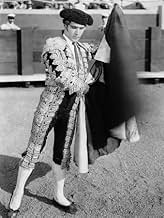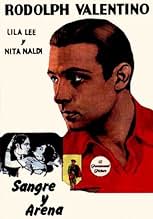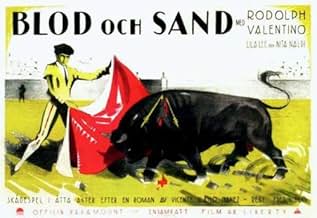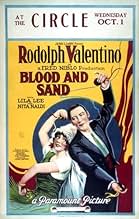PUNTUACIÓN EN IMDb
6,3/10
1,6 mil
TU PUNTUACIÓN
Juan es el hijo de una pobre viuda sevillana y, a pesar de eso, conseguirá llegar a ser un gran torero, reconocido en todo el país. En su ascendente carrera conocerá y se casará con Carmen, ... Leer todoJuan es el hijo de una pobre viuda sevillana y, a pesar de eso, conseguirá llegar a ser un gran torero, reconocido en todo el país. En su ascendente carrera conocerá y se casará con Carmen, una mujer honrada, bella y casta.Juan es el hijo de una pobre viuda sevillana y, a pesar de eso, conseguirá llegar a ser un gran torero, reconocido en todo el país. En su ascendente carrera conocerá y se casará con Carmen, una mujer honrada, bella y casta.
- Dirección
- Guión
- Reparto principal
- Premios
- 1 premio en total
Rudolph Valentino
- Juan Gallardo
- (as Rodolph Valentino)
Rosa Rosanova
- Angustias
- (as Rose Rosanova)
W.E. Lawrence
- Fuentes
- (as William Lawrence)
Michael Dark
- Doña Sol's New Lover
- (sin acreditar)
Reseñas destacadas
Most people picture Rudolph Valentino from his earlier roles in "Four Horsemen Of The Apocalypse" or "The Sheik". In this movie, Valentino plays a Matador in Spain and the story traces his rise and fall. Yes, he certainly was handsome and you see traces of his definate appeal here. For me, though, the movie was stolen by "the other woman", Dona Sol. She tarts her role up real well and plays it very broad, almost shockingly brazen for it's time. The scene where she tells Valentino that she longs to fell him beat her will make us wince, then she bites his hand while while in a semi-embrace in order to raise his passions. All stuff that seems pretty extreme for the typical innocent silent movie woman roles. The ending will be no surprise, it is telegraphed and alluded to many times during the movie. It's not Rudy at his absolute best, but I can recommend it.
The color cinematography which won an Oscar and the outstanding performances of stars Tyrone Power, Linda Darnell, and Rita Hayworth made the sound remake of Blood And Sand an enduring classic. But this silent version and much shorter version of Vincente Blasco Ibanez novel has a lot going for it.
Mostly it has Rudolph Valentino going for it. Valentino is cast well as the champion bullfighter of Spain who rises from poverty and marries the girl next door. But then this Samson of the Corrida throws it all away for the love of the Delilah like Dona Sol.
Lila Lee is the girl next door who Valentino marries and silent screen temptress Nita Naldi plays the beautiful and cruel Dona Sol. That one gets Valentino definitely going south of his Mason/Dixon line. In that sense Blood And Sand was a perfect Valentino picture because it had Valentino for the women to swoon over and Naldi for the men to drool over.
I did miss Laird Cregar playing the epicene critic Curo from the sound version. On the other hand there's Walter Long playing a bandit chief whose life as a lot of parallels to that of protagonist Juan Gallardo.
One thing that is radically different is that this silent version takes a position most against the sport of bullfighting. I'm betting that it was not popular in Spain or with Ernest Hemingway. The sound version has far more macho approach.
You'll have to decide for yourself which is better.
Mostly it has Rudolph Valentino going for it. Valentino is cast well as the champion bullfighter of Spain who rises from poverty and marries the girl next door. But then this Samson of the Corrida throws it all away for the love of the Delilah like Dona Sol.
Lila Lee is the girl next door who Valentino marries and silent screen temptress Nita Naldi plays the beautiful and cruel Dona Sol. That one gets Valentino definitely going south of his Mason/Dixon line. In that sense Blood And Sand was a perfect Valentino picture because it had Valentino for the women to swoon over and Naldi for the men to drool over.
I did miss Laird Cregar playing the epicene critic Curo from the sound version. On the other hand there's Walter Long playing a bandit chief whose life as a lot of parallels to that of protagonist Juan Gallardo.
One thing that is radically different is that this silent version takes a position most against the sport of bullfighting. I'm betting that it was not popular in Spain or with Ernest Hemingway. The sound version has far more macho approach.
You'll have to decide for yourself which is better.
Although in many ways "Blood and Sand" looks rather old-fashioned now, it's still an interesting drama. It gives Rudolph Valentino one of his better roles, and it is also highlighted by an effective supporting performance from Nita Naldi. The subject matter has some substance to it, and it still holds up well enough despite being handled occasionally in a somewhat heavy-handed manner.
In playing the bullfighter Gallardo, Valentino gets a character with some depth to it. The story follows him as he first struggles to achieve fame and respect, and then struggles in dealing with the side-effects of fame, fortune, and popularity. Naldi's role is memorable, and from her first appearance she makes her manipulative vamp character physically desirable but an obvious source of danger. Valentino does a good job playing off of her, and even without the benefit of spoken dialogue it is easy to see the struggle and self-reproach taking place inside of him.
The themes have a significance that go beyond the original setting. In itself, the criticisms of bullfighting and of what it reveals about human nature, while generally quite valid, are put forth without any subtlety. The inter-titles and the obvious parallels between Gallardo and the notorious criminal Plumitas repeatedly emphasize the same points that the action itself could have made well enough on its own. But that's one of the few weaknesses of "Blood and Sand". And the more general point, its depiction of how easy it is for crowds to be thrilled with violence, is well-taken.
The one other noticeable shortcoming is that the bullring scenes are now often unconvincing. It is laudable, of course, that the film-makers were willing to sacrifice realism so as to avoid being cruel to the animals, so this particular aspect of the movie should be evaluated generously. Present-day technology would certainly have made it much simpler to achieve both goals.
Although the style might make it mostly of interest to those who are already silent movie fans, there is still more than enough of interest to make this worth seeing. The story is simple, but it has some worthwhile aspects. Naldi provides something striking to look at, and Valentino gets to show what he can do with a role that has some possibilities to it.
In playing the bullfighter Gallardo, Valentino gets a character with some depth to it. The story follows him as he first struggles to achieve fame and respect, and then struggles in dealing with the side-effects of fame, fortune, and popularity. Naldi's role is memorable, and from her first appearance she makes her manipulative vamp character physically desirable but an obvious source of danger. Valentino does a good job playing off of her, and even without the benefit of spoken dialogue it is easy to see the struggle and self-reproach taking place inside of him.
The themes have a significance that go beyond the original setting. In itself, the criticisms of bullfighting and of what it reveals about human nature, while generally quite valid, are put forth without any subtlety. The inter-titles and the obvious parallels between Gallardo and the notorious criminal Plumitas repeatedly emphasize the same points that the action itself could have made well enough on its own. But that's one of the few weaknesses of "Blood and Sand". And the more general point, its depiction of how easy it is for crowds to be thrilled with violence, is well-taken.
The one other noticeable shortcoming is that the bullring scenes are now often unconvincing. It is laudable, of course, that the film-makers were willing to sacrifice realism so as to avoid being cruel to the animals, so this particular aspect of the movie should be evaluated generously. Present-day technology would certainly have made it much simpler to achieve both goals.
Although the style might make it mostly of interest to those who are already silent movie fans, there is still more than enough of interest to make this worth seeing. The story is simple, but it has some worthwhile aspects. Naldi provides something striking to look at, and Valentino gets to show what he can do with a role that has some possibilities to it.
You know the story even if you've never heard of this movie: young man becomes famous and starts cheating on his wife. Good characterizations and vivid backgrounds can't save the tired (even for its time) plot. Bullfighting scenes are more curious than exciting. Director Niblo's talents do not shine as brightly as in Ben-Hur 3 years later. The 1941 remake is better.
BLOOD AND SAND is one of those rare movies where the remake is actually much better--and this isn't because the remake was a sound movie and this one was silent. The problem is that the original Valentino film was a very traditional morality play that tried to please the more conservative film viewer of the day and ended up being rather heavy-handed and lacked depth. So, despite this being a film by America's most loved male sex symbol of the day, it is very pro-family and discusses the evils of extramarital affairs in a very obvious and superficial manner (the remake is slower paced and less preachy). This is odd, by the way, when you compare this film with two of Valentino's other famous performances. In THE SHIEK, there is a lot of sexual tension and the film is pretty racy for its day, as was THE FOUR HORSEMEN OF THE APOCALYPSE (which even included some nudity). It really is interesting how none of these films represent the average viewer--the movie is either anti-sex (like BLOOD AND SAND) or very pro-sex (like the other two). A truly interesting dichotomy.
¿Sabías que...?
- CuriosidadesThe film's editor was Dorothy Arzner, who would later go on to become Hollywood's first female director. Arzner impressed the producers by cannily interspersing stock bull-fighting footage with shots of Rudolph Valentino to make it look like the actor was actually in the ring with real bulls. This was quite a progressive technique in its day.
- PifiasThe mountain bandit who is one of the principal supporting characters is an anachronism; the Guardia Civil did away with their kind during the late 19th century.
- Citas
Juan Gallardo: We spread our capes for your amusement and most generous alms.
- ConexionesEdited into Michael Blanco (2004)
Selecciones populares
Inicia sesión para calificar y añadir a tu lista para recibir recomendaciones personalizadas
- How long is Blood and Sand?Con tecnología de Alexa
Detalles
Taquilla
- Recaudación en Estados Unidos y Canadá
- 2.725.000 US$
- Duración1 hora 48 minutos
- Mezcla de sonido
- Relación de aspecto
- 1.33 : 1
Contribuir a esta página
Sugerir un cambio o añadir el contenido que falta

Principal laguna de datos
By what name was Sangre y arena (1922) officially released in Canada in English?
Responde





































